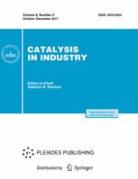Production of the biocatalysts on the base of heterologous xylanases recombinant producing strains in fungi Penicillium verruculosum. Their application in the hydrolysis of timber and woodworking industry waste
Abstract
Objectives are to create biocatalysts using recombinant strains of P. verruculosum with increased heterologous expression of endo-β-1, 4-xylanase P. canescens, to analyze the properties of new enzyme preparations, to explore of saccharifying ability of these drugs in the hydrolysis of various types of plant material, shredded aspen and deresined pine wood that is waste of timber and woodworking industry. Enzyme drugs of the present day have not xylanase activity high enough for hydrolysis of xylan rich biomass.Therefore, to obtain the recombinant strains based on the strain of P. verruculosum , containing homologous or heterologous genes of xylanase and mannanase with high activity of xylan conversion is relevant and practical. As a result, enzymes-biocatalysts has been obtained by genetic engineering methods for the hydrolysis of real herbal waste of sawmilling and wood industry. According to the chromatographic separation the obtained products have the following composition: 45–60 % cellulase, 20–50 % xylanase, this composition is optimal for the saccharification of bagasse, aspen and pine wood. The unique of the products is to obtain the biocatalysts with predetermined properties, which significantly reduces the cost of the enzyme, excluding the stage of mixing the individual components carbohydraze complex for hydrolysis of specific plant material – aspen and pine.
About the Authors
D. O. OsipovRussian Federation
A. M. Rozhkova
Russian Federation
V. Yu. Matys
Russian Federation
A. V. Koshelev
Russian Federation
O. N. Okunev
Russian Federation
E. A. Rubtsova
Russian Federation
A. G. Pravilnikov
Russian Federation
I. N. Zorov
Russian Federation
O. A. Sinitsyna
Russian Federation
I. N. Oveshnikov
Russian Federation
E. R. Davidov
Russian Federation
A. P. Sinitsyn
Russian Federation
References
1. Castellanos O. F., Sinitsyn A. P., Vlasenko E. Yu. Comparative evaluation of hydrolytic efficiency toward microcrystalline cellulose of Penicillium and Trichoderma cellulases // Bioresource Technol. 1995. Vol. 52. Р. 119–124.
2. Скомаровский А.А., Гусаков А.В., Окунев О.Н. и др. Гидролитическая способность ферментных препаратов из грибов родов Penicillium и Trichoderma // Прикл. биохимия и микробиология. 2005. Т. 41. № 2. С. 210–212.
3. Скомаровский А.А., Марков А.В., Гусаков А.В. и др. Новые целлюлазы для высокоэффективного гидролиза лигноцеллюлозной биомассы // Прикл. биохимия и микробиология. 2006. Т. 42. № 6. С. 674–680.
4. Berlin A., Gilkes N., Kilburn D. et al. Evaluation of novel fungal cellulases for ability to hydrolyze softwood substrates-evidence for the role of accessory enzymes // Enzyme Microb.Technol. 2005. Vol. 37. Р. 175–184.
5. Kurabi A., Berlin A., Gilkes N. et al. Enzymatic hydrolysis of steam-exploded and ethanol organosolv-pretreated Douglas fir by novel and commercial funded celluloses // Appl.Biochem.Biotechnol. 2005. Vol. 121–124. Р. 219–230.
6. Скомаровский А.А. Компонентный состав и гидролитичесвая способность ферментного комплекса Penicillium verruculosum: Автореф. канд. дис… канд. хим. наук, М.: МГУ, 2006.
7. Синицына О.А., Гусаков А.В., Окунев О.Н. и др. Рекомбинантная эндо-β-1,4-ксиланаза Penicillium canescens // Биохимия 2003. Т. 68. Вып. 1. С. 1631–1638.
8. Пат. 2288267 (РФ). 2006.
9. Aslanidis C., de Jong J.P. // Nucl.Acids Research. 1990. Vol. 18. Р. 6069–6075.
10. Sambrook J., Russell D. 3d ed. (2001) Molecular Cloning, A Laboratory Manual, Cold Spring Harbor Laboratory Press.
11. Aleksenko A.Y., Makarova N.A., Nikolaev I.V., Clutterbuck A.J. // Curr. Genet. 1995. Vol. 28. Р. 474–478.
12. Синицын А.П., Черноглазое В.М., Гусаков А.В. // Методы исследования и свойства целлюлолитических ферментов. М.: ВИНИТИ, 1990. Т. 25. С. 30–37.
13. Короткова О.Г., Семенова М.В., Морозова В.В. и др. Выделение и свойства грибных β-глюкозидаз // Биохимия, 2009. Т. 74. Вып. 5. С. 699–70.
14. Березин К.В., Рабинович М.Л., Синицын А.П. // Биохимия. 1977. Т. 42. № 9. С. 1631–1636.
Review
For citations:
Osipov D.O., Rozhkova A.M., Matys V.Yu., Koshelev A.V., Okunev O.N., Rubtsova E.A., Pravilnikov A.G., Zorov I.N., Sinitsyna O.A., Oveshnikov I.N., Davidov E.R., Sinitsyn A.P. Production of the biocatalysts on the base of heterologous xylanases recombinant producing strains in fungi Penicillium verruculosum. Their application in the hydrolysis of timber and woodworking industry waste. Kataliz v promyshlennosti. 2010;(5):64-71. (In Russ.)




























